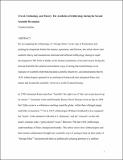Files in this item
Travel, technology, and theory : the aesthetics of ichthyology during the Second Scientific Revolution
Item metadata
| dc.contributor.author | Kreklau, Claudia | |
| dc.date.accessioned | 2018-11-05T11:30:08Z | |
| dc.date.available | 2018-11-05T11:30:08Z | |
| dc.date.issued | 2018-10-26 | |
| dc.identifier | 256419822 | |
| dc.identifier | ff6fdccb-9f58-41af-be13-f09e1b127425 | |
| dc.identifier | 85055886916 | |
| dc.identifier | 000448389800008 | |
| dc.identifier.citation | Kreklau , C 2018 , ' Travel, technology, and theory : the aesthetics of ichthyology during the Second Scientific Revolution ' , German Studies Review , vol. 41 , no. 3 , pp. 589-610 . https://doi.org/10.1353/gsr.2018.0095 | en |
| dc.identifier.issn | 0149-7952 | |
| dc.identifier.other | ORCID: /0000-0002-1621-5300/work/50167480 | |
| dc.identifier.uri | https://hdl.handle.net/10023/16397 | |
| dc.description.abstract | By investigating the ichthyology of "foreign fishes" in the age of exploration and printing developments before the advent of the camera, aquariums, and Darwin, this article shows that aesthetic theory and romanticism informed and inflected ichthyology during its rapid development between 1780 and 1830. This paper builds on the mutual constitution of art and science during the Second Scientific Revolution and aesthetic ways of seeing that treated beauty as an indicator of scientific truth preceding scientific objectivity, and demonstrates that by 1839, ichthyologists operated in an ontological framework that had integrated fish into nature and located the scientific viewer in a world of natural beauty. | |
| dc.format.extent | 22 | |
| dc.format.extent | 779734 | |
| dc.language.iso | eng | |
| dc.relation.ispartof | German Studies Review | en |
| dc.subject | QH Natural history | en |
| dc.subject | T-NDAS | en |
| dc.subject.lcc | QH | en |
| dc.title | Travel, technology, and theory : the aesthetics of ichthyology during the Second Scientific Revolution | en |
| dc.type | Journal article | en |
| dc.contributor.institution | University of St Andrews. School of History | en |
| dc.identifier.doi | https://doi.org/10.1353/gsr.2018.0095 | |
| dc.description.status | Peer reviewed | en |
This item appears in the following Collection(s)
Items in the St Andrews Research Repository are protected by copyright, with all rights reserved, unless otherwise indicated.

